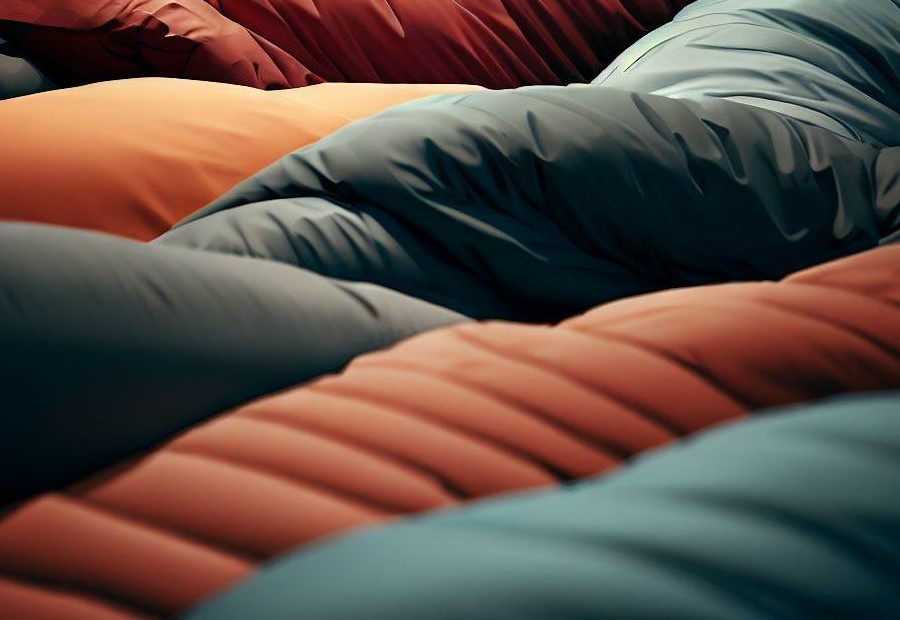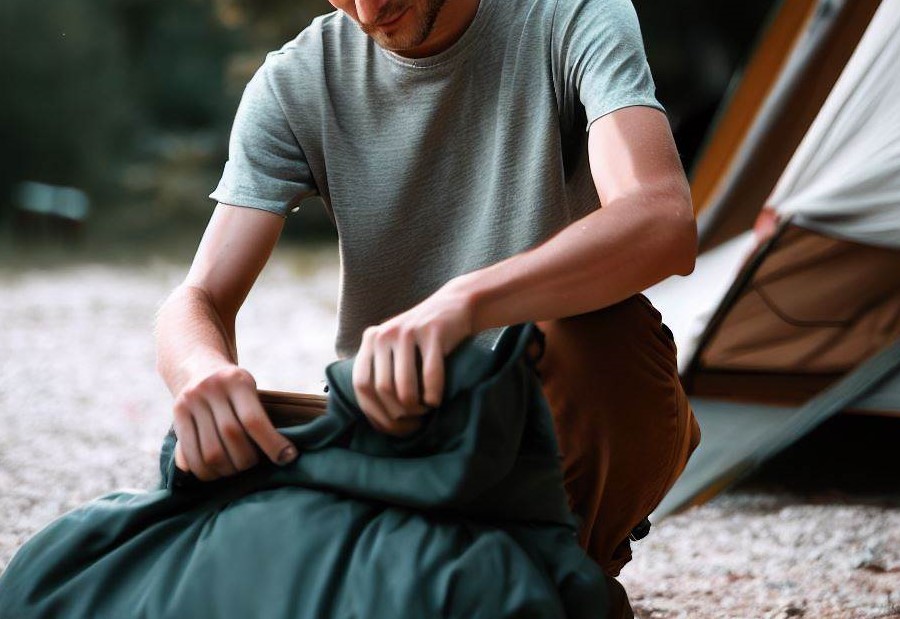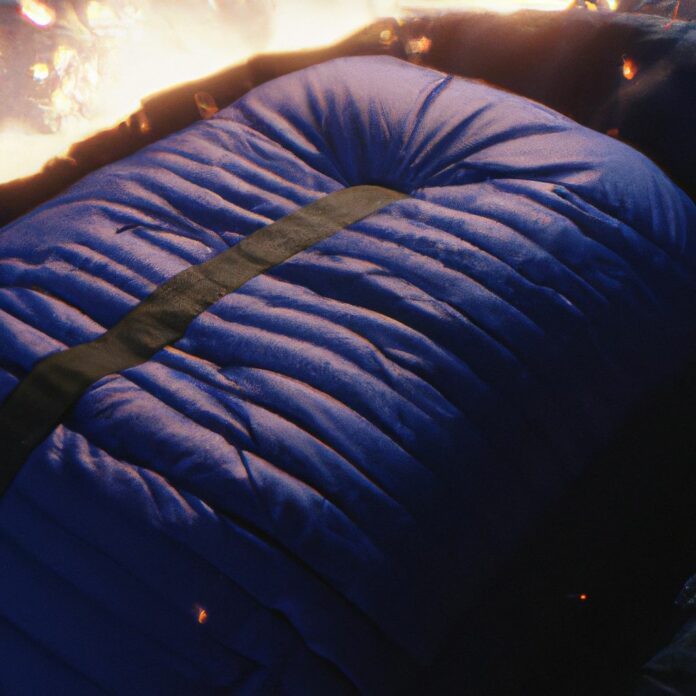Choosing the right sleeping bag is crucial for a comfortable and enjoyable outdoor adventure. With a wide range of options available, it can be overwhelming to find the ideal sleeping bag that meets your specific needs. In this guide, we will explore the key factors to consider when choosing a sleeping bag for outdoor adventures.
Considerations for Choosing a Sleeping Bag

When it comes to outdoor adventures, choosing the right sleeping bag is essential. In this section, we’ll take a look at key considerations you should keep in mind to ensure a cozy and comfortable night’s sleep.
From the temperature rating to the insulation type, weight and size, sleeping bag shape, and features, we’ll guide you through the factors that you need to weigh in order to make the perfect choice for your outdoor escapades. Let’s dive in and find the ideal sleeping bag for your next adventure!
Temperature Rating
When choosing a sleeping bag for outdoor adventures, one important consideration is the temperature rating. The temperature rating of a sleeping bag indicates the lowest temperature at which it will keep you warm and comfortable during the night.
| Temperature Rating | Temperature Range |
| Extreme Cold | Below -20°C |
| Very Cold | -20°C to -10°C |
| Cold | -10°C to 0°C |
| Cool | 0°C to 10°C |
| Mild | 10°C to 15°C |
| Warm | Above 15°C |
It is important to choose a sleeping bag with a temperature rating suitable for the expected conditions of your camping or hiking trip. If you anticipate camping in extremely cold temperatures, a sleeping bag with an extreme cold rating is recommended. On the other hand, for warmer climates, a sleeping bag with a mild or warm rating will suffice.
Remember, the temperature rating is a guideline and individual comfort levels may vary. If you tend to sleep cold or prefer extra warmth, it is advisable to choose a sleeping bag with a lower temperature rating than the expected conditions.
Additionally, consider factors such as the use of a sleeping pad, clothing layers, and personal sleeping preferences when making your decision.
Weight and Size
When considering the weight and size of a sleeping bag, it is important to find one that is suitable for your needs and preferences.
| Weight | Size |
| Weight: When it comes to choosing a sleeping bag, the weight is crucial, especially for backpacking or hiking trips where every ounce matters. Look for options that weigh between 1 to 2 pounds. | Size: Another important factor to consider is the size of the sleeping bag. You want it to be compact and not take up too much space in your backpack. Look for options that can be compressed down to a small size. |
| Standard: If weight is not a major concern for your general camping trips, a standard-weight sleeping bag weighing between 2.5 to 4 pounds should suffice. | Regular: To ensure a comfortable fit, choose a regular-sized sleeping bag designed to accommodate most adults. Make sure to check the dimensions and select a size that fits your body comfortably. |
| Heavy-duty: For extreme conditions or longer trips where durability is essential, opt for a heavy-duty sleeping bag, even if it weighs over 4 pounds. | Extra Large: If you prefer more space or are taller than average, consider an extra-large sleeping bag to ensure a comfortable fit. |
Pro-tip: Before purchasing a sleeping bag, always check the weight and packed size to ensure it aligns with your specific camping needs. Additionally, consider the intended use and weather conditions to determine the appropriate weight and size for your outdoor adventures.
Sleeping Bag Shape
When selecting a sleeping bag shape, it’s important to consider the specific keywords “Sleeping Bag Shape“.
The shape of the sleeping bag will determine how roomy and comfortable it feels, as well as its efficiency in keeping you warm. Here is a table outlining the two main types of sleeping bag shapes:
| Mummy Shape | The mummy shape sleeping bag is narrow at the feet and tapers towards the head, resembling the shape of a mummy. This shape provides the best thermal efficiency, as it minimizes dead air space and helps retain body heat. It is ideal for cold weather camping, backpacking trips, and mountaineering. |
| Rectangular Shape | The rectangular shape sleeping bag offers more room to move around and stretch out. It is spacious and comfortable, making it suitable for car camping and casual outdoor activities. However, this shape does not provide the same level of warmth as the mummy shape. |
When considering the appropriate sleeping bag shape for your needs, always keep in mind the keywords “Sleeping Bag Shape“. Consider the intended use and the conditions you will be camping in. If you prioritize warmth and weight efficiency, the mummy shape is a better choice.
If comfort and freedom of movement are more important, the rectangular shape is more suitable. Ultimately, choose a shape that aligns with your camping style and personal preferences.
Pro Tip: If you are unsure about the shape, consider trying out both types before making a purchase to determine which one provides the best balance between comfort and warmth for your specific needs.
Sleeping Bag Features
When choosing a Sleeping Bag Features, it’s important to consider the following features:
- Sleeping Bag Features Hood: A hood helps to keep your head warm and provides insulation.
- Sleeping Bag Features Zipper: Look for a high-quality zipper that is easy to open and close, especially if you anticipate using it frequently.
- Sleeping Bag Features Draft Collar: A draft collar is a tube-shaped collar that helps to prevent cold air from entering the bag through the neck area.
- Sleeping Bag Features Pockets and Storage: Some sleeping bags come with built-in pockets or storage compartments to keep small items within reach.
- Sleeping Bag Features Compression Sack: A compression sack allows you to compress your sleeping bag into a smaller size for easier transportation and storage.
It is important to choose a sleeping bag that has these Sleeping Bag Features to ensure comfort and functionality during your outdoor adventures.
How to Determine the Appropriate Temperature Rating?

When it comes to choosing the perfect sleeping bag for your outdoor adventures, one crucial factor to consider is the temperature rating. To ensure a comfortable and cozy night’s sleep, it’s important to determine the appropriate temperature rating for your sleeping bag.
In this section, we’ll explore how you can make this decision by understanding the temperature range of your destination and taking into account your personal sleeping preferences.
So, let’s stay warm and dive into the world of temperature ratings for sleeping bags!
Know the Temperature Range of Your Destination
Knowing the temperature range of your destination is crucial when choosing the right sleeping bag for your outdoor adventures. Here are some key points to consider:
- Research the climate: Find out the average temperature range and weather patterns of the place you will be camping in.
- Consider the season: Different seasons have varying temperature ranges. For example, winter camping requires a sleeping bag that can withstand freezing temperatures, while summer camping may require a bag that is suitable for warmer nights.
- Check the lowest temperature: Take note of the lowest temperature you expect to encounter during your trip. This will help you determine the lower limit of the temperature rating you should look for in a sleeping bag.
- Consider temperature fluctuations: If you expect significant temperature fluctuations during your trip, it’s important to choose a sleeping bag with a temperature rating that can handle these changes.
Keep in mind that these are general guidelines, and personal preferences and body warmth can also affect how you feel in different temperature conditions. It’s always better to choose a sleeping bag with a temperature rating that provides a buffer against colder temperatures than what you anticipate.
Fact: The temperature rating indicated on a sleeping bag is based on the assumption that the user is wearing appropriate insulation and using a sleeping pad for additional warmth.
Understand Your Personal Sleeping Preferences
Understanding your personal sleeping preferences is vital when selecting the appropriate sleeping bag. Every individual has varying needs and choices regarding their sleep environment.
First and foremost, take into account the temperature range in which you will be camping. If you have a tendency to feel cold easily, it may be wise to choose a sleeping bag with a lower temperature rating to ensure you remain warm throughout the night.
Conversely, if you tend to sleep hot, a sleeping bag with a higher temperature rating or one that offers excellent ventilation would be more suitable for you.
Additionally, consider the level of insulation you prefer. Some individuals prefer the lightweight and compressible nature of down insulation, while others may prefer the affordability and quick-drying properties of synthetic insulation. Understanding your personal insulation preferences will aid in narrowing down your options.
The shape of the sleeping bag is another crucial factor to consider. The mummy shape, which is more fitted and efficient at trapping heat, is ideal for colder temperatures. On the other hand, the rectangular shape provides more freedom to move around and is generally more comfortable for individuals who prefer to spread out while sleeping.
Lastly, contemplate any supplementary features that hold importance to you, such as a hood for added warmth, a temperature-regulating zipper, or pockets and storage options for conveniently keeping your essentials nearby.
By comprehending your personal sleeping preferences and taking these aspects into consideration, you can choose a sleeping bag that will not only provide comfort but also fulfill the functional requirements you need for a restful night’s sleep during your outdoor adventures.
Types of Insulation for Sleeping Bags
When it comes to choosing the perfect sleeping bag for your outdoor adventures, understanding the different types of insulation is key. In this section, we’ll dive into the world of insulation, exploring the benefits and unique characteristics of down insulation, synthetic insulation, and hybrid insulation.
So, grab a cup of coffee, because we’re about to embark on a cozy journey through the insulating wonders of sleeping bags. Get ready to discover the secrets of staying warm and comfortable in any camping situation!
Down Insulation
- Down insulation, made from the fine feathers found underneath the exterior feathers of ducks and geese, provides excellent warmth-to-weight ratio, trapping air to keep you warm in cold conditions.
- Highly compressible, down insulation allows the sleeping bag to be packed down small for easy transport.
- Known for its durability and longevity, down insulation retains its insulating properties even after repeated use.
- Naturally breathable, down insulation wicks away moisture and keeps you dry and comfortable during sleep.
When considering down insulation for your sleeping bag, it’s important to note that it can be more expensive than synthetic insulation.
However, the benefits of its superior warmth, lightweight design, and longevity make it a worthwhile investment for outdoor enthusiasts and adventurers.
Remember to check the fill power of the down insulation, as higher fill power indicates higher quality and greater insulation performance.
Keep in mind that down insulation may not be suitable for wet or humid conditions, as it can lose its insulating properties when wet.
Taking proper care of your sleeping bag, including storing it in a dry place and avoiding compression for long periods, will help maintain the effectiveness of the down insulation for years to come.
Synthetic Insulation
When considering which sleeping bag to choose, one important factor to consider is the insulation type. Synthetic insulation, such as synthetic insulation, is a popular choice for many outdoor enthusiasts due to its durability, affordability, and performance in wet conditions.
- High loft: Synthetic insulation is designed to mimic the warmth and loftiness of down insulation, providing excellent insulation in cold temperatures.
- Quick-drying: Unlike down insulation, synthetic insulation materials dry quickly, making them ideal for humid or wet environments.
- Moisture resistance: Synthetic insulation retains its insulating properties even when wet, ensuring you stay warm even if your sleeping bag gets damp.
- Hypoallergenic: Synthetic insulation fibers are non-allergenic and a good choice for those with allergies or sensitivities.
- Easy care: Synthetic sleeping bags are easy to clean and maintain, as they can be machine-washed and dried.
Pro-tip: To maximize the performance of your synthetic insulated sleeping bag, consider using a sleeping pad underneath for added insulation and comfort. This will help prevent heat loss to the ground, ensuring a more comfortable night’s sleep in colder temperatures.
Hybrid Insulation
Hybrid insulation combines the benefits of both down and synthetic insulation. It consists of a combination of down feathers and synthetic fibers. The down feathers provide excellent warmth-to-weight ratio and compressibility, while the synthetic fibers enhance the insulation’s ability to retain warmth even when wet. This combination makes hybrid insulation suitable for various weather conditions.
Hybrid insulation provides the warmth and lightweight properties of down while offering added durability and moisture resistance from synthetic fibers. It is ideal for outdoor activities where weather conditions may be unpredictable. It is often used in sleeping bags designed for backpacking, camping, and mountaineering.
With hybrid insulation, you can enjoy the benefits of both types of insulation, providing versatility and reliability. It offers a balance between warmth, weight, and protection against moisture, making it a popular choice among outdoor enthusiasts.
Understanding Sleeping Bag Shapes

When it comes to choosing the right sleeping bag for your outdoor adventures, understanding the different shapes is key.
In this section, we will dive into the world of sleeping bag shapes, exploring the benefits and unique features of the popular mummy shape and the versatile rectangular shape.
Get ready to discover how these shape choices can make all the difference in the comfort and functionality of your next camping trip.
Mummy Shape
| Mummy Shape |
| A mummy-shaped sleeping bag is designed to closely conform to the shape of your body, tapering towards the feet. This shape helps to minimize empty space inside the bag, which in turn reduces the amount of air that needs to be heated by your body. |
| This shape is ideal for cold weather camping or backpacking trips, as it offers better insulation and retains heat more efficiently compared to other shapes. |
| The mummy shape also helps to reduce overall weight and bulk, making it easier to carry and pack in your backpack. |
| Additionally, the hood of a mummy-shaped sleeping bag can be cinched tightly around your head, providing extra warmth and preventing cold air from entering. |
| However, some people may find the snug fit of a mummy-shaped sleeping bag restrictive or claustrophobic. |
| If you value warmth and weight savings, a mummy-shaped sleeping bag is a great choice for your outdoor adventures. |
Did you know? The term “mummy shape” is derived from the fact that the bag resembles an Egyptian mummy, with its close-fitting and tapered contours.
Rectangular Shape
When considering the shape of a sleeping bag, the rectangular shape is a popular choice for many outdoor adventurers. Here is a table highlighting the key features of a rectangular-shaped sleeping bag:
| Feature | Description |
|---|---|
| 1. | Spaciousness |
| 2. | Freedom of movement |
| 3. | Comfortable for side sleepers |
| 4. | Can be opened flat to use as a blanket |
| 5. | Easier to zip together with another rectangular bag |
Rectangular-shaped sleeping bags are especially suitable for those who prefer more space and freedom of movement while sleeping. If you like to stretch out or shift positions during the night, a rectangular shape offers ample room to do so. This shape is also great for side sleepers as it provides more space around the shoulders and hips.
Another advantage of a rectangular shape is that the bag can be opened fully and used as a blanket on warmer nights or when lounging around the campsite. Additionally, if you’re camping with a partner or a friend who also has a rectangular bag, you can easily zip the bags together, creating a larger sleeping space for two.
When choosing a sleeping bag, consider your sleeping preferences and the type of outdoor adventures you’ll embark on. The rectangular shape might be the perfect choice for those seeking comfort, space, and versatility.
Important Features to Look for in a Sleeping Bag
When it comes to choosing the perfect sleeping bag for your outdoor adventures, paying attention to certain key features is crucial. In this section, we’ll explore the important aspects to consider when selecting a sleeping bag.
From the protective hood to the convenience of pockets and storage, each sub-section will uncover the essential features that can make or break your camping experience. So, let’s dive in and discover the must-have elements that will ensure a cozy and comfortable night’s sleep under the stars.
Hood
When selecting the perfect sleeping bag, it is essential to take into account the hood. The hood acts as a protective shield for your head and plays a vital role in keeping you warm and at ease during outdoor expeditions.
| Importance | Insulation | Adjustability | Comfort |
| The hood serves the purpose of trapping heat and preventing it from escaping your body. | Search for a sleeping bag with a well-insulated hood to provide additional warmth. | Adjustable drawstrings give you the ability to tighten or loosen the hood based on your preference, ensuring a snug fit. | Ensure that the hood is soft and cushioned for maximum comfort as it will be in direct contact with your head. |
A thoughtfully designed hood can significantly impact your warmth, particularly during colder nights or in severe weather conditions. It aids in retaining heat from your head, a crucial area for temperature regulation. As a result, when selecting a sleeping bag, carefully consider the quality and functionality of the hood.
To enhance your outdoor experience, contemplate a sleeping bag with a hood that is well-insulated, offering adjustability and maximum comfort. This will guarantee that you remain snug and shielded throughout your adventures.
Remember, when it comes to the hood, prioritize insulation, adjustability, and overall comfort to make your camping or backpacking trips more enjoyable and restful.
Zipper
The zipper of a sleeping bag plays a crucial role in providing convenience and functionality during outdoor adventures. It allows easy access to the inside of the sleeping bag and enables you to adjust ventilation according to your comfort level. When considering the zipper, there are a few factors to keep in mind:
| Zipper Type | Determines the ease of use and durability of the zipper. Choose between coil zippers, which are lightweight and ideal for backpacking, and heavy-duty zippers for more rugged use. |
| Zipper Length | Consider whether you prefer a full-length zipper for maximum ventilation or a shorter zipper to save on weight and reduce the potential for heat loss. |
| Zipper Location | Some sleeping bags have zippers on the side, while others have them on the front or even both. Decide on the location that suits your entry and exit preferences. |
| Zipper Quality | Ensure the zipper is of high quality and functions smoothly without snagging or getting stuck. Opt for zippers with reliable reputations for long-lasting performance. |
Draft Collar
The draft collar is a crucial component to keep in mind when selecting a sleeping bag.
One of the key benefits of a draft collar is its ability to prevent cold air from entering the sleeping bag through the neck area. It is a well-padded collar that snugly wraps around the neck, creating a tight seal and trapping warmth inside.
Typically filled with insulation, the draft collar provides additional warmth and effectively blocks drafts from chilling the body on cold nights.
This feature is especially important for camping in lower temperatures or for individuals who tend to get colder while sleeping.
Having a draft collar significantly enhances the overall warmth and comfort of the sleeping bag, ensuring a more restful night’s sleep.
When purchasing a sleeping bag, it is crucial to verify if it includes a draft collar and to ensure that it properly fits around the neck area in order to maximize insulation.
Opting for a sleeping bag with a draft collar will greatly benefit those seeking extra warmth and comfort during their outdoor adventures.
Pockets and Storage
When it comes to choosing the right sleeping bag, pockets and storage are crucial elements to take into account for your outdoor adventures:
- Pockets: It is important to look for a sleeping bag that provides ample pockets for convenient storage of small items such as your phone, flashlight, or personal belongings. The availability of pockets within reach can greatly enhance your camping experience, making it more organized and hassle-free.
- Storage: The overall storage capacity of the sleeping bag should be considered. Look for features like a compression sack that allows you to compress the bag for easy storage and portability. This is especially beneficial when you have limited space available in your backpack or tent.
- Accessibility: It is essential to ensure that the pockets are easily accessible, either from the inside or outside of the sleeping bag. This way, you can easily reach for your essentials without the need to unzip or open the entire bag.
- Durability: Opt for a sleeping bag with sturdy and well-constructed pockets. This will prevent any tearing or damage, ensuring that your items remain secure throughout your camping trip.
- Waterproofing: Considering a sleeping bag with waterproof pockets or storage compartments is advisable. This will effectively protect your belongings from moisture or water in case of unexpected rain or damp conditions.
By taking these factors into consideration, you can choose a sleeping bag with sufficient pockets and storage options that will meet your needs and elevate your overall outdoor experience.
Compression Sack
When it comes to choosing the right sleeping bag for your outdoor adventures, the compression sack is an essential factor to consider. Here are some key points to keep in mind:
- A compression sack is a storage bag that allows you to compress your sleeping bag into a smaller size, making it easier to carry and pack.
- It is usually made of lightweight and durable materials, such as nylon, to withstand the rigors of outdoor use.
- The size of the compression sack should be suitable for your sleeping bag, ensuring a snug fit to maximize compression.
- Compression sacks typically have adjustable straps or compression straps that allow you to tighten and secure the bag, reducing the overall volume.
Pro-tip: Before compressing your sleeping bag, make sure it is completely dry to prevent any moisture from trapping inside, which could lead to unpleasant odors or damage to the insulation. Additionally, avoid over-compressing the bag, as this can affect its loft and insulation properties over time. Happy camping!
Tips for Proper Care and Maintenance of Sleeping Bags

Here are some tips for proper care and maintenance of sleeping bags:
- Clean your sleeping bag properly: Follow the manufacturer’s instructions to effectively clean your sleeping bag. Spot clean stains and use a mild detergent for a full wash. Avoid using bleach or harsh chemicals.
- Avoid overstuffing: When storing your sleeping bag, avoid cramming it tightly into a stuff sack. Overstuffing can compress the insulation, reducing its loft and warmth.
- Air out your sleeping bag: After each use, give your sleeping bag some time to air out and dry before storing it. This will help prevent mold and mildew growth.
- Store your sleeping bag properly: Store your sleeping bag in a large, breathable sack or hang it in a cool, dry place. Avoid long-term compression, as it can damage the insulation.
- Use a sleeping bag liner: A sleeping bag liner can help protect your sleeping bag from sweat, oils, and dirt, extending its lifespan. It also adds an extra layer of insulation, enhancing warmth.
By following these tips for proper care and maintenance of sleeping bags, you can ensure that your sleeping bag remains clean, warm, and in excellent condition for many outdoor adventures to come!
Frequently Asked Questions
What factors should I consider when choosing a sleeping bag for outdoor adventures?
When choosing a sleeping bag for outdoor adventures, it is important to consider factors such as the type of trip, location, and your personal preferences. Additionally, factors like body temperature, the use of a sleeping pad, and the insulation level of the bag are also important.
What is the recommended temperature rating for a three-season sleeping bag?
A basic three-season sleeping bag with a temperature rating of around 32 degrees Fahrenheit is suitable for most situations. However, it is important to note that temperature ratings on sleeping bags are not always accurate, so it’s best to choose a slightly lower temperature rating than what you think you’ll need.
What are the differences between down and synthetic insulation in sleeping bags?
There is a choice between down and synthetic insulation for sleeping bags. Down insulation is lighter and more compressible, offering superior warmth. However, it loses its insulating properties when wet. On the other hand, synthetic insulation is more durable and retains insulation even when wet, making it suitable for moist environments.
How do I determine the proper size and fit for a sleeping bag?
Sizing and fit can vary among sleeping bags, so it’s best to try out different bags in a gear shop to find the right size and fit for you. Testing the sleeping bag before purchasing is important to ensure a good fit and proper insulation.
What are some recommended top picks for backpacking sleeping bags?
Some top picks for backpacking sleeping bags include the REI Co-op Magma 15, The North Face Furnace 35, Feathered Friends Hummingbird UL 30, Nemo Disco 30, and Enlightened Equipment Enigma. These options offer a balance of weight, warmth, and durability for outdoor adventures.
How can I ensure ethical and environmentally friendly choices when choosing a sleeping bag?
When choosing a sleeping bag, it is important to consider the ethical and environmental impact. Look for sleeping bag manufacturers that prioritize sustainability, ethical sourcing of materials, and fair labor practices.
Additionally, practicing Leave No Trace ethics and following local regulations while enjoying outdoor adventures can help minimize your impact on the environment.

